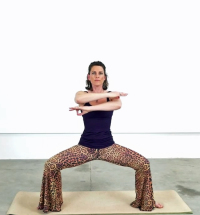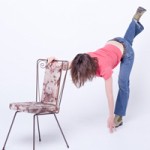by Kara-Leah Grant
Welcome to the fourth Creative Sun Salutation Abundance flow here on The Yoga Lunchbox.
This week we explore a transition posture as we move from the front of the mat to the back of the mat – an important part of working with circular sun salutations.
In this particular variation, I’m using a squat to make that transition, which gives us a greater sense of our roots or foundation. Squatting is all about our relationship to the earth – we have to both surrender downward while maintaining a strong sense of internal support.
Think of a tree. It grows deep roots into the earth but it’s trunk rises strongly towards the sky. This it the energy of a squat.
Releasing into a squat requires an open pelvis and a strong flow of apana, or grounding energy.
It’s also important to make sure that the upper body doesn’t sink passively into the lower body – this creates compression through the joints and means there is no sense of strength in the posture. The energy is only moving down, instead of being supported as well.
Working with movement within the posture helps to ensure that this collapse of the upper body into the lower body doesn’t happen.
In particular, I’ve found using pelvis pulsations, which I learned from Shiva Rea, an extraordinarily powerful way of making squat an active posture rather than a passive one.
However, this technique doesn’t just work on a muscular level – it’s also working energetically with the bandhas.
In the video I reference “tucking the tailbone under” however I need to adjust my language to make it more anatomically correct. The tailbone is lengthened towards the ground, rather than tucked under. This lengthening flattens out all three spinal curves – lumber, thoracic and cervical (axiel extension) and naturally engages the bandhas.
This engagement of the bandhas then helps to internally support the posture even as there is a letting go and release towards the ground.
Internally, it’s difficult to let go and release energy downward unless you feel supported and held – otherwise everything would just melt into a puddle on the ground.
The second technique is another I learned from Shiv Rea – working with the feet on the ground. In particular, lifting the heels up one at a time, and then both at once. The raised heel assists with the external rotation of the thighs plus it also activates the feet and helps to send energy down into the earth while lifting it up towards the sky.
It’s that dynamic tension again which so often creates postures. We press down through the ball of the foot and lift up through the heel at the same time.
Often our feet are not as strong or as active as we think, and working with the heels helps to mobilise our feet and shows up any weaknesses. We may find we weight completely through the ball of the big toe, or the ball of the little toe. Once the feel is raised, if this is the case, it’s almost impossible to hold our balance.
Finally today, we work with a strong arm position which again can be held passively – just placing the arms in a shape and letting them be there – or worked strongly and creating dynamic tension within the stillness.
Enjoy playing in squat and remember – use my instruction as a diving off point, and go play!
This video is designed to be used after you’ve learned and integrated Week 1, Week 2 & Week 3 into your practice.
If you haven’t yet watched and played with those videos, make sure that is where you start.
After you add this segment to your sequence, you may wish to finish off the evolving sun salutation anyway that works for you. Make sure you do both sides!
Next week, we’ll add a fifth part, until at the end of our six weeks we have a complete Abundance Sun Salutation.
If you have any questions about the practice, please leave a comment.
If you’re reading this in an email, you won’t be able to see the video – you have to go to the article on the website for that, and you need to be an Insider to access the full article with video.
Inside the Box only costs $NZ35/yr or $5/month, you can find out more & sign up here.
The Ups and Downs of Mastering Squat Pose
Want to experience more Abundance on the Yoga Mat?
You can sign up for workshop I’m teaching in Napier, December 12 & 13 2014, The Bhavana Immersion.
We’re covering four feeling states, including abundance. Find out more here.
I’ll also be teaching an Abundance Flow at Wanderlust Great Lake Taupo January 29 – February 1, 2015. You can buy tickets here and see my teaching schedule here.


Leave a Reply